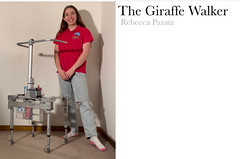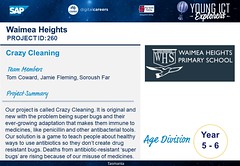Western Australia
Year 3 – 4
First Place
Rubbish bot
Maddison Bushell, Darcey Forrester, Stella Stuart, Taylor Brown
Perth College
People always leave their waste in parks and do not bother to pick it up. Pollution is having a direct impact on sensitive species or habitats. In our local park we come across loads of rubbish. The Rubbish Bot will detect, collect and then put the rubbish in the right coloured recycle bin. For example, bottles in the recycle bin. The Rubbish Bot is solar powered which makes the machine operate during daylight hours. The Rubbish Bot has a sensor in the front to detect rubbish. When it has located rubbish. The Rubbish Bot also senses when it is at full capacity & returns to the bin storage to empty its load. At night time, the Rubbish Bot connects to a park bin for safe keeping whilst it stores excess solar energy in its battery pack. The Rubbish Bot has a home detector which means it’ll only stay in its park.
Second Place
Mr Happy Face
Rayhan Sheriff, Timmy Nguyen, Cyrus Addenbrooke
Swan View Primary School
Our project is about a friendly man that helps your feelings get better. Firstly, he helps you get better. If you are sick and alone, you have no friends you can play with Mr Happy Face! He will help you when your angry or sick or sad or disappointed. Secondly, Mr Happy Face can play with you there is lot of games you can play with him. Thirdly, you can take him anywhere and talk to him whenever you want you can also program him and share with EVERYONE it doesn’t have to be family it can be anyone! This works by micro:bit and it recognizes you if you touch him. Mr Happy Face Is Ready to Play with you!
Third Place
Pet Scratcher
Steven Osborn, Thomas Di Stasio
Bertram Primary School
The pet Scratcher will automatically start scratching or patting a cat or a dog. It will do this by using a crank driven by a motor that causes a patting hand to stroke the back and or head of the pet. It also can scratch a pet if you change the patting attachment to one that can scratch.
Year 5 – 6
First Place
HI.LED
Elizabeth Townsley, Miette Egerton-Warburton
St Hilda’s Anglican School for Girls
The Year 6 Community Service students at our school help with a Breakfast Club at Mosman Park Primary School. Some of the students are hearing impaired. We learned from their teacher that they find their drumming lessons particularly challenging because they can’t hear if they are playing correctly. We have invented the HI.LED to help them enjoy their drumming lessons and make progress. We have used an Arduino, 4 breadboards, LEDS, microphone, text display screen, wires, resistors and code to give the students feedback on their drumming via different coloured LEDs and text.
Second Place
The Tremor Tamer
Zara Pease, Suria Hee, Poppy Spurling
Perth College
The Tremor Tamer is a wrist and hand brace or glove that supports the limb. It has embedded sensors that pick up how intense the tremor is and respond by sending electrical currents or pulses to ease the muscle tension and tremors. We plan to embed a TENS unit or an EMS unit to provide the currents. Physiotherapists use these machines. Our invention will help people with tremors in one or both hands. Around 80 percent of people with Parkinson’s have tremors in their hands and arms. Shaky hands make it difficult to write, fasten buttons, apply make-up, thread a needle, using a computer and anything that requires fine motor skills. Parkinson’s Disease is a degenerative neurological condition that affects a person’s control of their body movement.
Third Place
Williamdoro Translate
William Doroszenko
West Beechboro Primary School
Williamdoro Translate is a project helping people who may not have a second language understand foreign languages such as Turkish and Italian. It provides the spelling of the word along with a pronunciation of it. This aims to help more people have second languages and understand foreign languages.
Year 7 – 8
First Place
SIDS Saviour
Mia George, Sophie Morgan, Rani Cirkovic, Joyan Zho
St Hilda’s Anglican School for Girls
The SIDS Saviour device enables parents to monitor the baby for possible suffocation from rolling by informing the parents via an alarm. The small device is attached to the clothing of the baby as well as in the mattress. When the two devices make contact, it sends an alarm to a mobile phone.
Second Place
The Smart Detector
Levi Fletcher, Rehema Jarega, Josie Murray
Rehoboth Christian College
This smart detector will perform three tasks. Firstly, it can be attached to a computer and inform the teacher that the person is on the computer in class. Secondly, it can be attached to a mobile phone. When the phone is picked up, the driver will be informed by an alarm. Lastly the detector can be attached on a bin. When the bin has been opened for too many times (eg. 20 times), it will give off a gentle sound, reminding the home users that there may be too much food wasting.
Year 9 – 10
First Place
The OWO Bike Project
Eason Huang
Providence Christian College
OWO Bike project is an Internet-based, computer-controlled bike-sharing system in the concept of designing a bike with a smart lock connected to a smartphone through the Internet using IOT(internet of things) technology, GPS(Global Positioning System) and Bluetooth Pairing technology. It changes the way of riding a bike. People can find bikes somewhere around their street and go to places nearby, such as supermarkets, schools, offices, and parks instead of driving cars, so the issues of lacking parking areas can be alleviated. In addition, users can get more exercise by riding OWO Bikes for daily commute; this can decrease the population of people having obesity and other diseases caused by lack of exercise. Furthermore, OWO Bike smart locks could be sold individually to people so that they can install these locks on their own bikes for lease. It increases the communication between people and the liveability of a city.
Second Place
S & R-X
Deegan Mellor, Julian Ranieri, Bianca Patio
Lumen Christi College
The S&R-X (Search and Rescue vehicle / expedition) will be used to navigate through rough terrain that other vehicles cannot go through due to the size of most high-powered vehicles. It will have the ability to autonomously navigate terrain with the help of ardupilot on a Pixhawk. It will be 75cm long and will be constructed out of steel and aluminum. An example of when the S&R-X would be used is if it needed to go to a remote civilization to deliver items such as medical supplies and the local people will most likely not speak English so the Raspberry Pi Will have a translator that detects the persons language and converts it from speech to text and then it will translate the text into English and then play it in the pilot’s headset. The pilot can communicate with the people and guide them on how to use the equipment or what supplies it has brought. It will have the ability to carry payload for necessary missions.
Third Place
master-mind
Ashley Djakaria, Alyssa Warren
St Hilda’s Anglican School for Girls
‘master-mind’ is an app created to aid teens stay calm and motivated in their daily lives. Having a variety of different wellbeing activities to choose from and motivational messages, master-mind aims to foster organisational skills, motivate and support our users as well as add structure to people’s lives.



